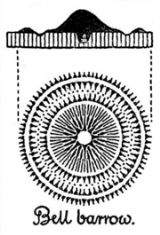
Bell barrow
Encyclopedia
A bell barrow, sometimes referred to as a Wessex type barrow, campanulate form barrow, or a bermed barrow is a type of tumulus
identified as such by both John Aubrey
and William Stukeley
.
 In the United Kingdom
In the United Kingdom
they take the form of a circular mound or mounds within a circular ditch, the mounds being separated from the ditch and each other by a berm
. There is sometimes present an additional bank, external to the ditch. The ditch is typically the source of the material used to create the mound and is therefore described as a "quarry-ditch". A burial pit beneath the mound usually contains human remains, sometimes cremated, sometimes simply interred. Grave goods such as daggers or pottery vessels are commonly found within the burial pit also. An example at Sutton Veny
included a bronze-age wooden coffin. The bell barrow Milton Lilbourne 2 in Wiltshire
has no burial associated with it. Most bell barrows in the United Kingdom date to the early Bronze Age
.
Leslie Grinsell constructed a typology
for bell barrows:
Tumulus
A tumulus is a mound of earth and stones raised over a grave or graves. Tumuli are also known as barrows, burial mounds, Hügelgrab or kurgans, and can be found throughout much of the world. A tumulus composed largely or entirely of stones is usually referred to as a cairn...
identified as such by both John Aubrey
John Aubrey
John Aubrey FRS, was an English antiquary, natural philosopher and writer. He is perhaps best known as the author of the collection of short biographical pieces usually referred to as Brief Lives...
and William Stukeley
William Stukeley
William Stukeley FRS, FRCP, FSA was an English antiquarian who pioneered the archaeological investigation of the prehistoric monuments of Stonehenge and Avebury, work for which he has been remembered as "probably... the most important of the early forerunners of the discipline of archaeology"...
.

United Kingdom
The United Kingdom of Great Britain and Northern IrelandIn the United Kingdom and Dependencies, other languages have been officially recognised as legitimate autochthonous languages under the European Charter for Regional or Minority Languages...
they take the form of a circular mound or mounds within a circular ditch, the mounds being separated from the ditch and each other by a berm
Berm
A berm is a level space, shelf, or raised barrier separating two areas. Berm originates in the Middle Dutch and German berme and came into usage in English via French.- History :...
. There is sometimes present an additional bank, external to the ditch. The ditch is typically the source of the material used to create the mound and is therefore described as a "quarry-ditch". A burial pit beneath the mound usually contains human remains, sometimes cremated, sometimes simply interred. Grave goods such as daggers or pottery vessels are commonly found within the burial pit also. An example at Sutton Veny
Sutton Veny
Sutton Veny is a small village situated in the Wylye Valley, about 2 miles south east of the town of Warminster in Wiltshire, England. 'Sutton' means south farmstead in relation to Norton Bavant, one mile to the north...
included a bronze-age wooden coffin. The bell barrow Milton Lilbourne 2 in Wiltshire
Wiltshire
Wiltshire is a ceremonial county in South West England. It is landlocked and borders the counties of Dorset, Somerset, Hampshire, Gloucestershire, Oxfordshire and Berkshire. It contains the unitary authority of Swindon and covers...
has no burial associated with it. Most bell barrows in the United Kingdom date to the early Bronze Age
Bronze Age
The Bronze Age is a period characterized by the use of copper and its alloy bronze as the chief hard materials in the manufacture of some implements and weapons. Chronologically, it stands between the Stone Age and Iron Age...
.
Leslie Grinsell constructed a typology
Typology (archaeology)
In archaeology a typology is the result of the classification of things according to their characteristics. The products of the classification, i.e. the classes are also called types. Most archaeological typologies organize artifacts into types, but typologies of houses or roads belonging to a...
for bell barrows:
- Type Ia: A single mound with a narrow berm
- Type Ib: A single mound with a normal berm
- Type Ic: A single mound with a wide berm
- Type II: Two mounds
- Type III: Three mounds
- Type IV: Four mounds

